- Analytics
- News and Tools
- Market News
CFD Markets News and Forecasts — 01-05-2022
- WTI reverses Friday’s pullback from one-week high with mild gains inside a bullish chart pattern.
- 200-SMA, support line of the rising channel restrict short-term downside amid firmer RSI.
- Five-week-old resistance line guards recovery moves, MACD signals easing bullish bias.
WTI bounces off short-term key support while reversing the previous day’s U-turn from the monthly hurdle. That said, the black gold prints half a percent of intraday gains as buyers attack $104.00 during Monday’s Asian session.
In doing so, the energy benchmark takes a U-turn from the convergence of the 200-SMA and the lower line of the one-week-long rising channel. Also favoring the buyers is the firm RSI condition (14), currently around 55.00.
The recovery moves currently aim for another battle with the downward sloping resistance line from late March, near $105.45 by the press time.
Following that, the upper line of the stated channel and the monthly peak, respectively around $107.90 and $109.15, will be on the WTI bull’s radars.
Alternatively, WTI sellers will wait for a clear downside break of the $102.60 support confluence for fresh entry.
Even so, an ascending support line from April 11, at $96.30 by the press time, will add to the downside filters before directing bears towards the monthly low of $92.64.
WTI: Four-hour chart
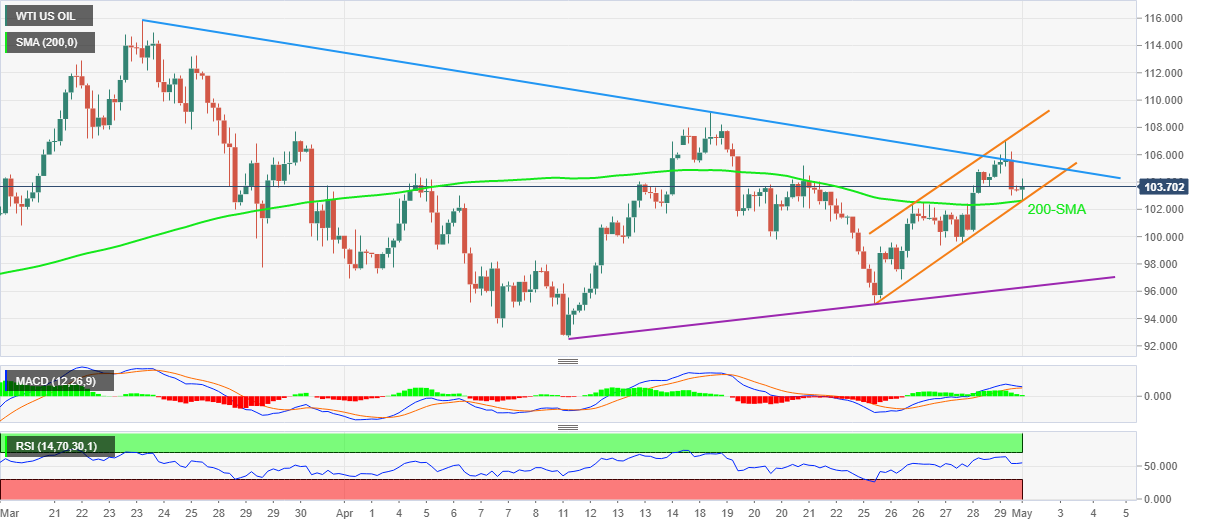
Trend: Recovery expected
- USD/CAD is facing barricades near 1.2860 as investors await PMI’s release.
- A jumbo rate hike by the Fed looks imminent.
- Oil prices look to surpass $105.00 as Germany sees ending its dependence on Russian oil by late summer.
The USD/CAD pair is struggling to overstep 1.2860 as investors are on the sidelines ahead of the release of the US and Canada’s Purchase Managers Index (PMI) data on Monday. Investors are seeing a standard outperformance from the US economy as the Institute for Supply Management (ISM) is expected to print the US PMI at 58 against the prior print of 57.1. While, the oil-exporting economy sees a release of its PMI by the S&P Global at 57.9 against the previous figure of 58.9, which indicates an underperformance.
The week is going to be full of rough moves as the Federal Reserve (Fed) will dictate the interest rate decision. Investors should brace for higher uncertainty even though the market participants have already priced in the jumbo rate hike from Fed. The market participants will keep an eye on the extent of hawkish guidance from the Fed. The Fed looks committed to returning to neutral rates as early as possible to tame multi-decade high inflation rates. Therefore, Fed will focus on shoring up its policy rates swiftly.
Meanwhile, the oil prices have climbed to near $105.00 in the Asian session on an expectation of elevating supply concerns. Germany could end its dependence on Russian oil by the end of the summer, as per Bloomberg. This has bolstered the odds of a European embargo on the Russian oil imports, which will strengthen the supply concerns and henceforth the prices of oil in the global market.
- AUD/USD licks its wounds at two-month low, snaps two-day downtrend amid a sluggish Asian session.
- Aussie PMIs came in upbeat for April but Chinese activities contract amid covid resurgence.
- RBA, Fed both are up for rate hikes but the pace of normalization will be the key to watch.
- US ISM Manufacturing PMI will entertain intraday traders, NFP is also important for clear directions.
AUD/USD consolidates recent losses around the multi-day bottom near 0.7050 during the quiet Asian session on Monday. The pair’s latest rebound could be linked to the upbeat PMI data for April at home, as well as mildly bid US stock futures. However, anxiety ahead of this week’s monetary policy meetings by the Fed and the Reserve Bank of Australia (RBA), as well as China’s covid woes, keep the bears hopeful.
Australia’s AiG Performance of Mfg Index for April grew past 55.7 to 58.5 while the Markit Manufacturing PMI also crossed the 57.7 figure flashed in March to 58.8 in April. However, China’s PMIs for April came in softer than expected and prior, with the headline NBS Manufacturing PMI declining to 47.4 versus 48 forecast and 49.5 previous reading.
That said, the S&P 500 Futures rise 0.33% by the press time even as Wall Street closed with heavy losses on Friday. The market’s latest moves could be linked to the recently easing expectations that the Fed would go all-in to normalize the balance sheet while also announcing a 0.50% rate hike.
At home, the RBA is likely to announce a 0.15% increase to the benchmark rate on Tuesday. However, the policymakers’ view for the next moves, vis-à-vis the Fed action, will be crucial to watch as well.
Other than the central banks, worsening virus conditions in China, amid the holiday mood, join the Ukraine-Russia crisis to exert downside pressure on the AUD/USD prices.
That being said, the US US ISM Manufacturing PMI for April, expected 58.0 versus 57.1 prior, will direct short-term AUD/USD moves ahead of the key RBA and the Fed. Also important will be Friday’s US Nonfarm Payrolls (NFP).
Technical analysis
Unless providing a daily close beyond the August 2021 bottom of 0.7105, AUD/USD prices remain directed towards the yearly low of 0.6966.
- EUR/USD fades bounce off five-year low as the Fed week begins.
- Fed’s 0.50% rate hike is in the offing but USD bulls seek clues on balance-sheet normalization to dominate further.
- ECB’s de Guindos rules out July rate-hike concerns, Holzmann hints at rate hikes in summer or autumn.
- EU oil embargo on Russia, German Retail Sales and US ISM Manufacturing PMI to direct intraday moves.
EUR/USD rebound turns weary as traders brace for the much-awaited Fed verdict during the early hours of Monday’s Asian session. That said, the major currency pair portrayed the first positive daily close in seven the previous day but struggles around 1.0550-40 of late as market participants remain cautious ahead of the key event, as well as weigh the latest development as negative for the quote.
Although the US Dollar Index (DXY) eased from the five-year high on Friday, the EUR/USD prices portrayed a 100-pip worth of corrective pullback. Even so, the quote remains pressured around the lowest levels since 2017 as this week’s Federal Reserve (Fed) meeting and pre-NFP anxiety challenge the recovery moves.
Also weighing on the EUR/USD prices are the latest comments from the European Central Bank (ECB) policymakers, who raised economic concerns but deferred from Fed policymakers when it comes to rate hike signals. Recently, European Central Bank (ECB) Vice President Luis de Guindos said, “ECB rate hike possible but not likely in July,” per Bloomberg. On the same line was ECB Governing Board member Robert Holzmann who signaled rate hike in summer or autumn.
On the contrary, the Fed is all set to announce a 0.50% rate hike during Wednesday’s meeting. However, major attention will be given to the comments relating to the balance-sheet normalization and economic forecasts.
It’s worth noting that the fears of economic recession in the old continent, due to the Ukraine-Russia crisis, also weigh on the EUR/USD prices. Even so, the bloc remains sturdy to exert economic pressure on Moscow for its invasion of Kyiv. Recently, Germany’s energy security report signaled that the nation will end dependence on Russian oil by the end of this summer.
Other than the ECB and geopolitical crisis, China’s covid conditions and firmer US data, as well as reflation fears, also underpin the US dollar’s demand and praise the EUR/USD prices.
As a result, the EUR/USD pair may remain pressured but the cautious mood ahead of this week’s key events may restrict the downside moves. That said, today’s German Retail Sales for March and the US ISM Manufacturing PMI for April can offer intraday directions.
Also read: EUR/USD Weekly Forecast: Stairway to hell, NFP and Fed likely to fuel the current trend
Technical analysis
Friday’s corrective pullback couldn’t cross a downward sloping previous support line from November 2021, around 1.0590 by the press time, which in turn directs EUR/USD traders towards the latest multi-month low of 1.0471.
- GBP/USD is oscillating below 1.2600 as investors are seeing forward to rate hike announcements.
- The Fed is going to elevate its interest rate by 50 bps.
- A 25 bps rate hike is expected by the BOE.
The GBP/USD pair is hovering around 1.2580 and is likely to extend further amid a rebound in the risk-sensitive currencies, witnessed on Friday. The cable attracted significant bids around 1.2510 as responsive buyers found it a value bet and drove it higher. The asset is expected to deliver wild moves this week as the market participants are awaiting the announcement of the interest rate hike by the Federal Reserve (Fed) and Bank of England (BOE) this week.
The Fed is going to bring tremendous uncertainty in the FX domain amid its dominance and expectation of a jumbo rate hike. Multi-decade inflation print at 8.5% and consistency in full-employment levels are advocating a 50 basis point (bps) interest rate hike from Fed policymakers. Along with the hawkish tone on rate announcements, hawkish guidance from the Fed is also expected to contain the inflation mess.
On the sterling front, the Bank of England (BOE) is going to continue the streak of raising interest rates. The BOE elevated its rates in its last meet by 50 bps. This time a similar extent is not expected as the street is forecasting a quarter to a percent rate hike but the streak of hiking the rates will continue to remain intact.
Although interest rate decisions from the Fed and BOE will remain in the spotlight this week, investors will also focus on the US Manufacturing PMI, which is due in the New York session. A preliminary reading for the ISM Manufacturing PMI is 58 against the prior print of 57.1.
- NZD/USD remains depressed near yearly low, printing eight-day downtrend.
- US dollar bulls cheer hawkish expectations from Fed, safe-haven appeal of the greenback.
- RBNZ’s measured response, China’s covid woes weigh on Kiwi prices.
- US ISM Manufacturing can offer intermediate directions but risk catalysts are more important for traders to watch.
NZD/USD holds onto bearish impulse around a 20-month low, flashed the previous day, despite grinding between 0.6480 and 0.6450 since late Friday. That said, the Kiwi pair’s latest bounce-off intraday low fails to gain any appreciation as it remains well confined in the aforementioned range during the initial hour of Monday’s Asian session.
Broad US dollar strength joins China’s covid-linked lockdowns to double-down Antipodeans like NZD/USD. However, the market’s anxiety ahead of Wednesday’s New Zealand (NZ) employment report for the first quarter of 2022 and the US Federal Reserve (Fed) monetary policy meeting seems to have restricted the quote’s recent moves.
The US Dollar Index (DXY) remains around the highest levels in two decades despite snapping a six-day uptrend on Friday. Mainly underpinning the greenback’s strength are the rising odds of the Fed’s faster rate hikes and the urge for balance-sheet normalization amid roaring inflation. Also pushing the USD higher is the geopolitical tension between Ukraine and Russia, as well as between Moscow and the West, due to the greenback’s traditional safe-haven appeal.
Elsewhere, China’s covid conditions pose a big challenge to the global commodity traders due to the dragon nation’s status as the world’s largest industrial player. Recently, China’s PMIs for April came in softer than expected and prior, with the headline NBS Manufacturing PMI declining to 47.4 versus 48 forecast and 49.5 previous reading.
It’s worth noting that Beijing has also tightened measures to curb the virus spread and announced a major covid testing drive even during the festive season lasting till Wednesday.
Amid these plays, equities and riskier assets remain weak and exert downside pressure on the Antipodeans like NZD/USD while strong US Treasury yields underpin the greenback bulls.
Moving on, today’s US ISM Manufacturing PMI for April, expected 58.0 versus 57.1 prior, can offer intraday directions to NZD/USD prices. However, major attention will be given to Wednesday’s NZ jobs report as the Reserve Bank of New Zealand (RBNZ) recently sounded a bit reserved. Also, the Fed’s rate hike and push for normalization will be crucial for the pair traders to watch for clear directions.
Technical analysis
Although oversold RSI conditions restrict the short-term downside of the NZD/USD prices, buyers are less likely to take the risk until witnessing a clear break of the August 2020 low around 0.6490.
Alternatively, the June 2020 trough near 0.6390 and a descending support line from August 2021, close to 0.6370 by the press time, lure the bears.
- Gold Price is expecting a fresh bullish impulsive wave as the RSI (14) has shifted into a bullish range.
- Fed’s policy this week will keep investors on the tenterhooks.
- Soaring inflation is hinting at a jumbo rate hike by the Fed.
Gold (XAUUSD) Price witnessed a decent corrective move to mildly below $1,900 after hitting a high of $1,920.02 on Friday. The precious metal went into a correction mode after a firmer rebound from a low of $1,872.22 on Thursday. The bright metal found a decent pullback from a high of $1,920.02 as expectations of an interest rate hike by the Federal Reserve (Fed) got bolstered by higher-than-expected Personal Consumption Expenditure (PCE) by the US Bureau of Labor Statistics. The yearly PCE landed at 6.6%, higher than the market consensus of 6.5% and the prior print of 6.3%. While, the monthly figure printed at 0.6%, much higher than the forecasts and the previous outcome of 0.5%.
Soaring inflation is hinting at a jumbo rate hike by the Fed on Wednesday. Also, the market estimates are aiming at a 50 basis point (bps) interest rate hike by the Fed this week. Fed chair Jerome Powell is going to feature a mega-rate hike and along with that investors will focus on the dictation over the balance sheet reduction. Demand for a sheer liquidity squeeze from the economy is strongly required to leash the roaring inflation. Therefore, investors should brace for a tight liquidity environment this year, which is continue to keep the precious metal on the tenterhooks. Apart from the rate hike announcement and balance sheet reduction, the third catalyst, which will remain in the spotlight, is further guidance. Investors are very much curious to get insights into the neural rate reversion roadmap as it will display the extent of aggressiveness by Fed policymakers.
Also read: Gold Weekly Forecast: XAU/USD's gains to remain limited on demand-side dynamics
Meanwhile, the US dollar index (DXY) is firmly holding above 103.00 as an aggressive hawkish tone by Fed chair Jerome Powell and his colleagues look imminent. The DXY faced some correction on Friday after printing a fresh 19-year high at 103.93 on Thursday as profit-booking dragged the asset lower. Usually, an asset faces some exhaustion in an uptrend gradually as it comes closer to the event. The 10-year US Treasury yields are approaching 3% vigorously on expectations of a higher interest rates environment going forward.
On Monday, investors will focus on the release of the ISM Manufacturing PMI, which is expected to land at 58 against the prior print of 57.1. A higher-than-expected reading will hurt the gold prices.
Gold technical analysis
On an hourly scale, XAUUSD is trading near the 50% Fibonacci retracement (placed from last week low at $1,872.24 to Friday’s high at $1,920.02) at $1,896.35, at the press time. The asset is likely to find a bullish impulsive wave after completing its correction to near 61.8% Fibo retracement at $1,890.70.
The Relative Strength Index (RSI) (14) has displayed a bullish range shift. The momentum oscillator remained in a bearish range of 20.00-40.00 and a directionless radius of 40.00-60.00 for a long period but has managed to shift into a bullish range of 60.00-80.00 and will focus on supporting itself from gyrating into a bearish range.
Gold hourly chart
- USD/JPY correcting from fresh cycle highs ahead of the Fed.
- Fed is expected to raise rates by 50bp at its 3-4 May meeting and announce quantitative tightening.
USD/JPY was on the back foot on Friday and was trading at a low of 129.31 as the pair corrects in a W-formation. For the open, the pair is steady ahead of what will be a busy week for the pair.
With the help of a dovish Bank of Japan, the pair traded at a new high at 131.25 last week from which the bulls threw in the towel taking profits into month-end. However, by sticking with ultra-loose policy, the BoJ cannot expect anything except further yen weakness in the face of a hawkish Federal Reserve.
In comments following the announcements and a commitment to buy an unlimited amount of government bonds in order to keep 10-year yields at about 0%, BoJ Governor Haruhiko Kuroda emphasized that the current rise in inflation was being driven mainly by higher costs. This means that the BoJ wishes to abstain from tightening policy for now.
In stark contrast, the Fed is expected to raise rates by 50bp at its 3-4 May meeting and simultaneously announce quantitative tightening. This will result in an asset reduction of around USD95bn per month. Back-to-back 50bp hikes in June and July are also anticipated.
Consequently, the US dollar continues to firm along with the higher yields. Analysts say that this ''can be chalked up to the dollar smile theory that suggests the dollar will gain during periods of strong U.S. data and rising U.S. rates as well as bouts of risk-off sentiment.''
''Furthermore, we must stress that negative developments in the rest of the world (Russian gas supplies, dovish BOJ, etc.) are playing a big part in the dollar’s strength by highlighting relative fundamentals that favor the greenback.''
- AUD/USD bears are in control and a break of 0.7050 could be on the cards for the open.
- DXY is correcting on the daily chart ahead of the Fed.
AUD/USD will be in focus for the open given yet further disappointments in Chinese data from the weekend, China's purchasing managers indices fell deeper into contraction in April, and the technicals are poised for further downside ahead.
The following illustrates the bearish bias across the time frames.
AUD/USD monthly chart
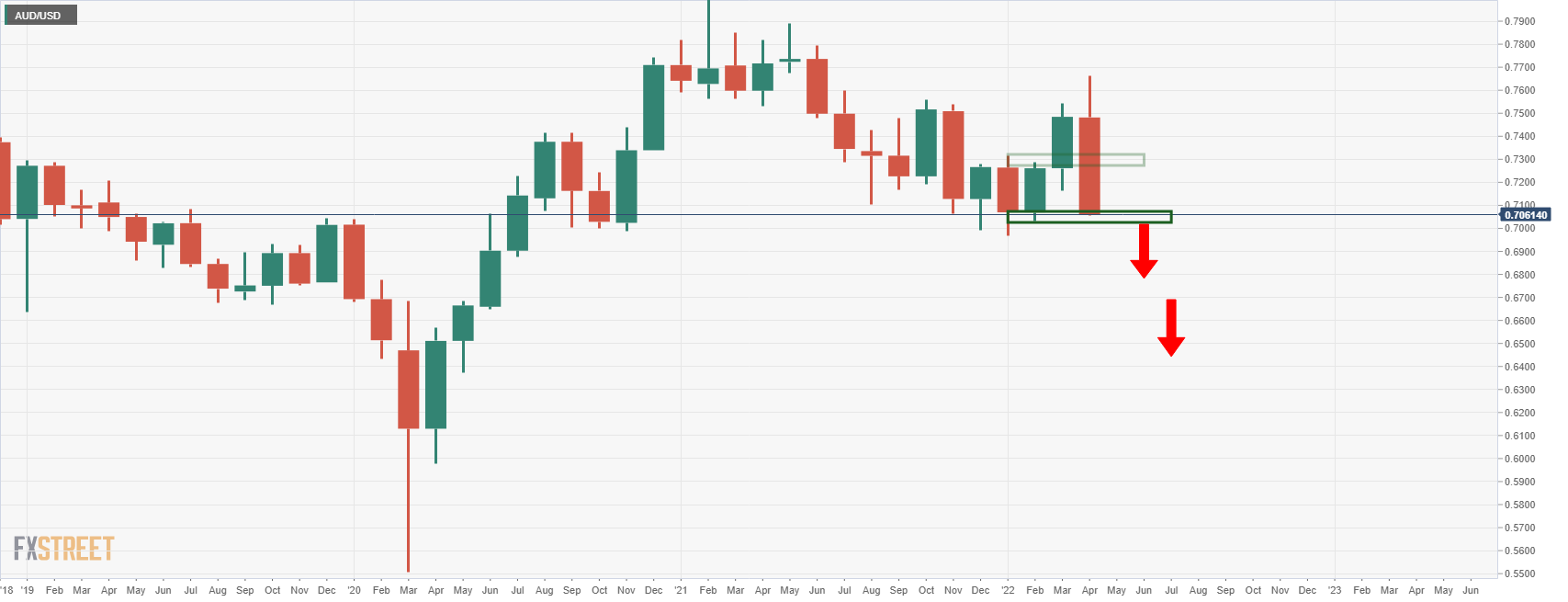
The W-formation's neckline was broken which leaves the outlook bearish for the foreseeable future.
AUD/USD weekly chart
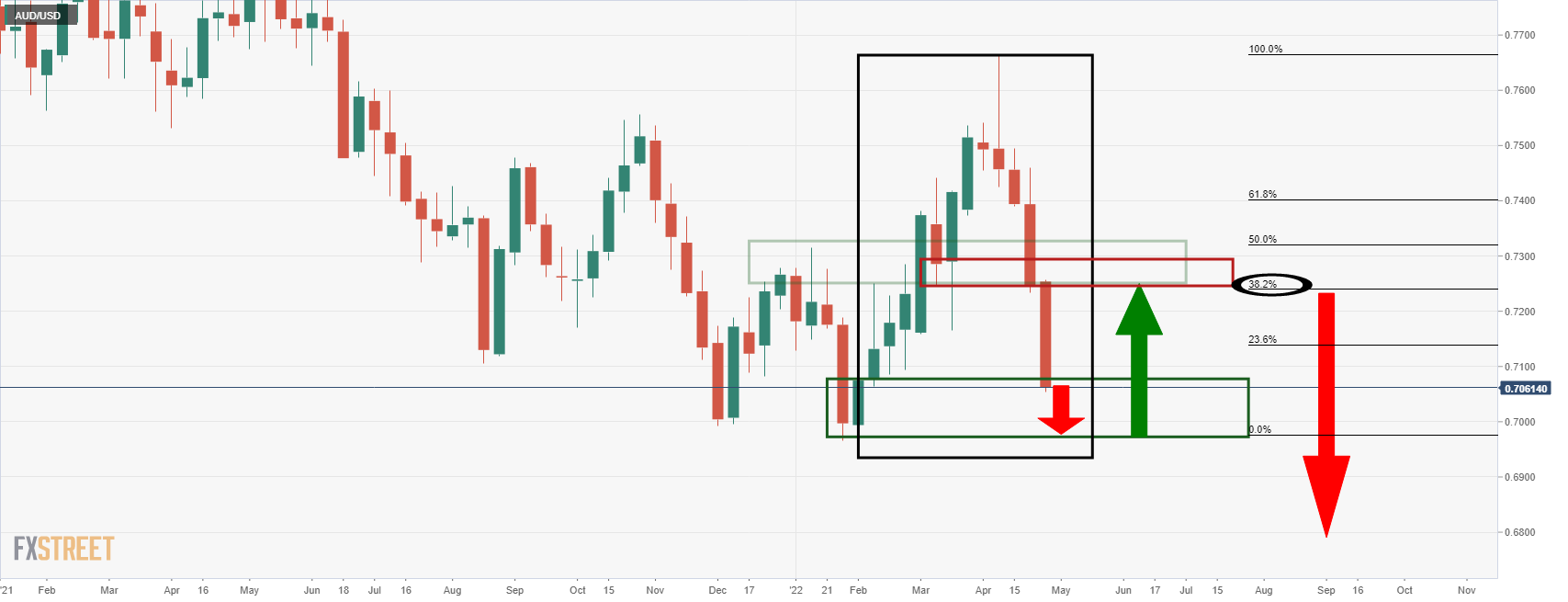
The price is in a strong downtrend that has recently accelerated and the prior lows into the 0.6960s are in focus.
AUD/USD daily chart
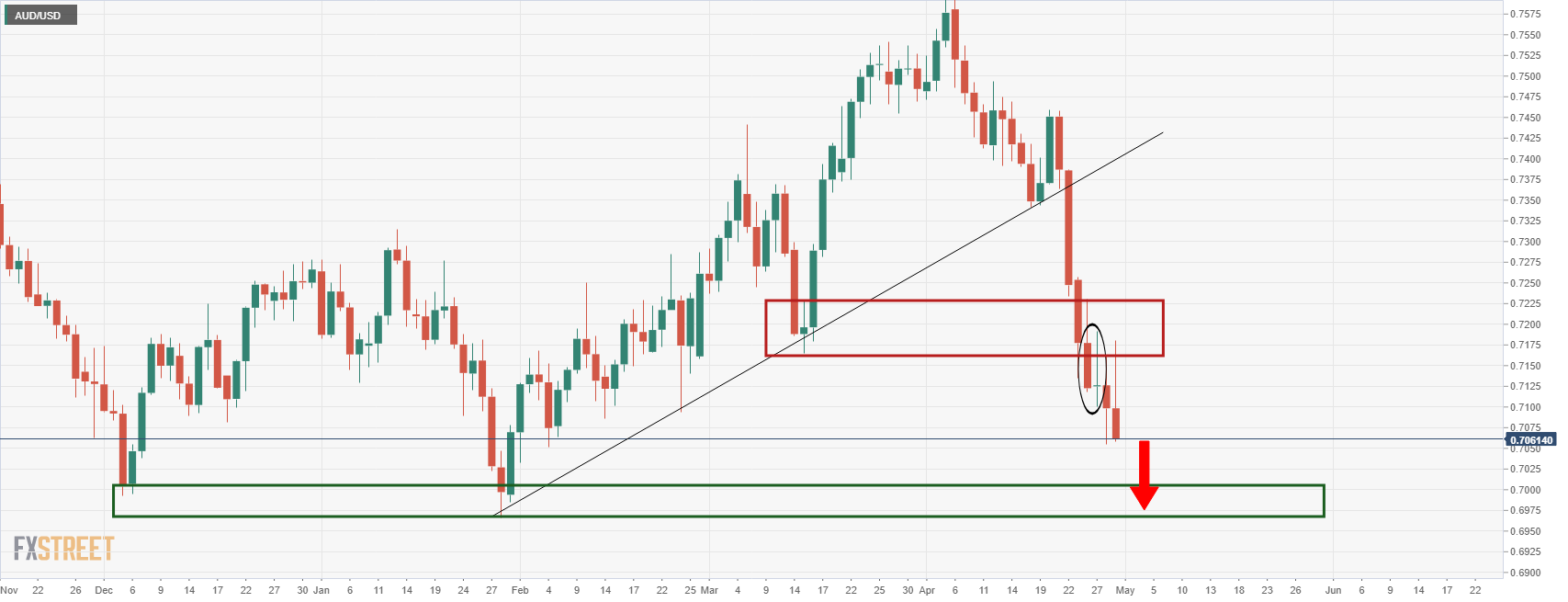
The bulls failed to take over control and lost their footing on attempts to break 0.72 the figure. The price action is bearish and a break of 0.7050 is on the cards for the opening sessions.
AUD/USD H4
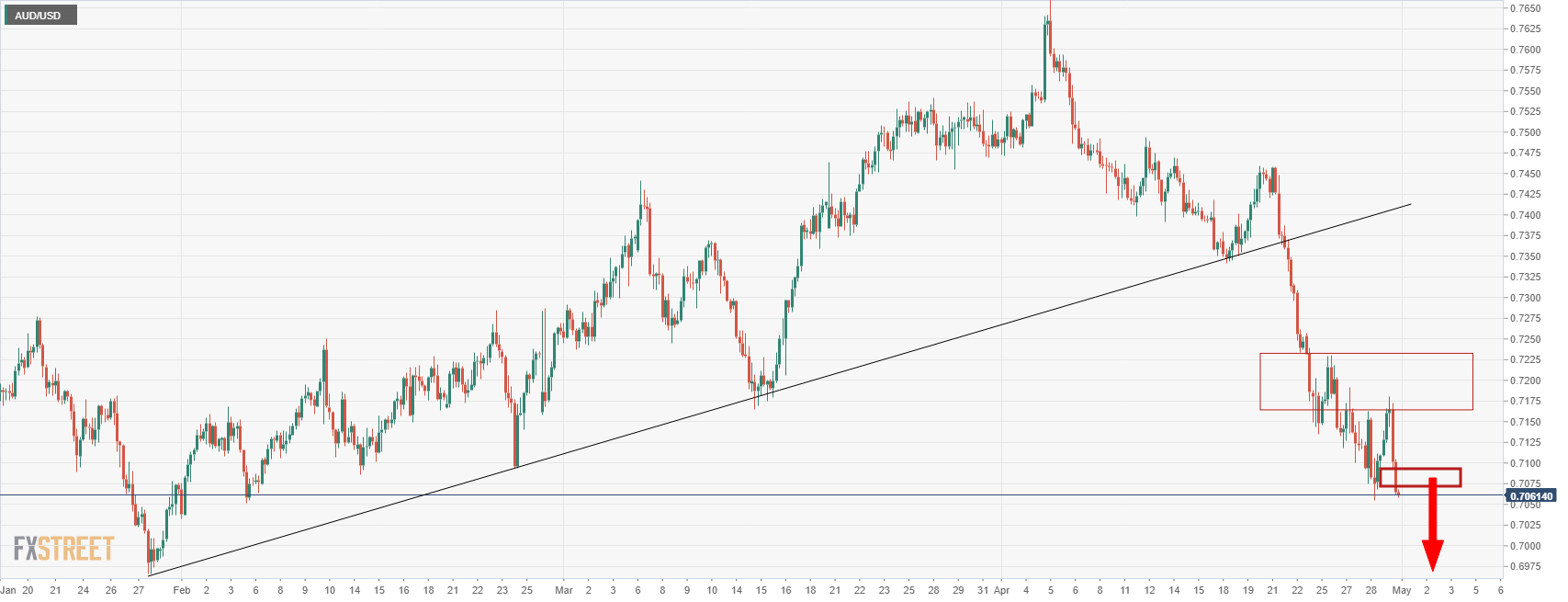
The four-hour chart's price action also leans bearish below the prior lows and the bears could be going in for the kill at this juncture.
US dollar corrects
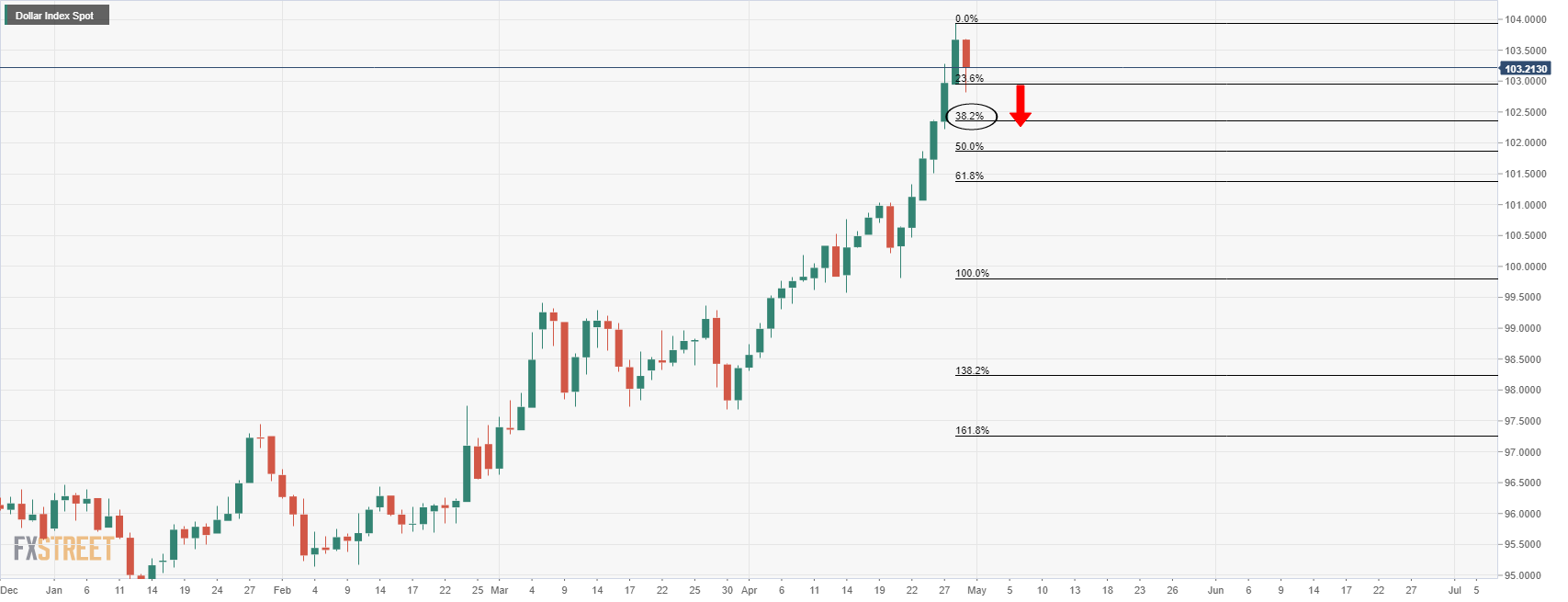
The US dollar, however, is on the backfoot and could be in for some more supply in the days ahead. This could be a spanner in the works for AUD bears.
In weekend data releases, China's purchasing managers indices fell deeper into contraction in April, particularly the services PMI. This follows a poor close on Wall Street on Friday as a technology sell-off continued to conclude the biggest monthly selloff since 2008 for the NASDAQ. With the Chinese data, it could be a grim start to the week in Asia.
The details of the manufacturing PMI were worse than the headline, with almost all components hitting their lowest since COVID lows in February 2020. Chinese activity has slowed, especially in the services sector in the wake of widespread lockdowns.
''The PMI data suggests the economy is even worse shape than many had predicted, and we continue to see growth undershooting the official target of around 5.5%,'' analysts at TD Securities argued.
Meanwhile, China's offshore currency has weakened to its lowest since October 2020, pressured by concern surrounding China’s growth outlook and a surge in US Treasury yields.
Demand concerns are a driver for oil prices amid continued lockdowns in the Middle Kingdom. However, the prospect of the EU banning Russian crude has once again shifted focus toward the ever-present supply risks.
In weekend news, the European Union is reported to be set to propose a ban on Russian oil by the end of the year, with restrictions on imports introduced gradually until then, according to people familiar with the matter.
The EU will also push for more banks from Russia and Belarus to be cut off from the international payment system SWIFT, including Sberbank, and a decision could be made as soon as this week at a meeting of the bloc’s ambassadors.
© 2000-2024. All rights reserved.
This site is managed by Teletrade D.J. LLC 2351 LLC 2022 (Euro House, Richmond Hill Road, Kingstown, VC0100, St. Vincent and the Grenadines).
The information on this website is for informational purposes only and does not constitute any investment advice.
The company does not serve or provide services to customers who are residents of the US, Canada, Iran, The Democratic People's Republic of Korea, Yemen and FATF blacklisted countries.
Making transactions on financial markets with marginal financial instruments opens up wide possibilities and allows investors who are willing to take risks to earn high profits, carrying a potentially high risk of losses at the same time. Therefore you should responsibly approach the issue of choosing the appropriate investment strategy, taking the available resources into account, before starting trading.
Use of the information: full or partial use of materials from this website must always be referenced to TeleTrade as the source of information. Use of the materials on the Internet must be accompanied by a hyperlink to teletrade.org. Automatic import of materials and information from this website is prohibited.
Please contact our PR department if you have any questions or need assistance at pr@teletrade.global.
-637870406263891051.png)















